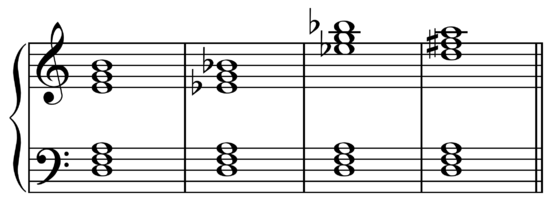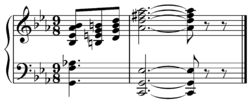
Polychord
Encyclopedia

Music
Music is an art form whose medium is sound and silence. Its common elements are pitch , rhythm , dynamics, and the sonic qualities of timbre and texture...
and music theory
Music theory
Music theory is the study of how music works. It examines the language and notation of music. It seeks to identify patterns and structures in composers' techniques across or within genres, styles, or historical periods...
, a bichord or polychord consists of two or more chord
Chord (music)
A chord in music is any harmonic set of two–three or more notes that is heard as if sounding simultaneously. These need not actually be played together: arpeggios and broken chords may for many practical and theoretical purposes be understood as chords...
s, one on top of the other. In shorthand they are written with the top chord above a line and the bottom chord below, for example F above C:
 .
.The use of polychords may suggest bitonality
Polytonality
The musical use of more than one key simultaneously is polytonality . Bitonality is the use of only two different keys at the same time...
or polytonality. Harmonic parallelism may suggest bichords.
Examples may be found in Igor Stravinsky
Igor Stravinsky
Igor Fyodorovich Stravinsky ; 6 April 1971) was a Russian, later naturalized French, and then naturalized American composer, pianist, and conductor....
's Petrushka
Petrushka
Petrouchka or Petrushka is a ballet with music by Russian composer Igor Stravinsky, composed in 1910–11 and revised in 1947....
, p. 15, and Rite of Spring
The Rite of Spring
The Rite of Spring, original French title Le sacre du printemps , is a ballet with music by Igor Stravinsky; choreography by Vaslav Nijinsky; and concept, set design and costumes by Nicholas Roerich...
, "Dance of the Adolescents" (1921) (see Petrushka chord
Petrushka chord
The Petrushka chord is a recurring polytonic device used in Igor Stravinsky's ballet Petrushka and in later music. These two major triads, C major and F# major - a tritone apart - clash, "horribly with each other," when sounded together and create a dissonant chord.-Structure:The Petrushka chord is...
). They may also be found in the song "Point of No Return" from Andrew Lloyd Webber
Andrew Lloyd Webber
Andrew Lloyd Webber, Baron Lloyd-Webber is an English composer of musical theatre.Lloyd Webber has achieved great popular success in musical theatre. Several of his musicals have run for more than a decade both in the West End and on Broadway. He has composed 13 musicals, a song cycle, a set of...
's The Phantom of the Opera
The Phantom of the Opera (1986 musical)
The Phantom of the Opera is a musical by Andrew Lloyd Webber, based on the French novel Le Fantôme de l'Opéra by Gaston Leroux.The music was composed by Lloyd Webber, and most lyrics were written by Charles Hart, with additional lyrics by Richard Stilgoe. Alan Jay Lerner was an early collaborator,...
, including chords such as Em over Fm.

Ninth chord
A ninth chord is a chord that encompasses the interval of a ninth when arranged in close position with the root in the bass.A dominant ninth is a dominant chord with a ninth. A ninth chord, as an extended chord, typically includes the seventh along with the basic triad structure. Thus, a Cmaj9...
with upper extensions," but the octave separation of the 3rd makes the suggestion of, "two independent triads with their a m9 apart," even more likely, and the 4th is a, "split-third chord."
Extended chord
Extended chord
In music, extended chords are tertian chords or triads with notes extended, or added, beyond the seventh. Ninth, eleventh, and thirteenth chords are extended chords...
s contain more than one triad
Triad (music)
In music and music theory, a triad is a three-note chord that can be stacked in thirds. Its members, when actually stacked in thirds, from lowest pitched tone to highest, are called:* the Root...
, and so can be regarded as a type of polychord:

 . (C=D)
. (C=D)The Lydian augmented scale
Lydian augmented scale
In music, the Lydian augmented scale is the third mode of the ascending melodic minor scale.Starting on C, the notes would be as follows: C - D - E - F# - G# - A - B - C'Generically the whole and half steps are: - W - W - W - W - H - W - H -...
, "has a polychord sound built in," created by superimposing the Caug and the Emaj and/or Fdim triads that exist in the scale, this being, "a very common practice for most bop
Bebop
Bebop differed drastically from the straightforward compositions of the swing era, and was instead characterized by fast tempos, asymmetrical phrasing, intricate melodies, and rhythm sections that expanded on their role as tempo-keepers...
and post-bop
Post-bop
Post-bop is a term for a form of small-combo jazz music that evolved in the early-to-mid sixties. The genre's origins lie in seminal work by John Coltrane, Miles Davis, Bill Evans, Charles Mingus, Wayne Shorter and Herbie Hancock...
players [such as McCoy Tyner
McCoy Tyner
McCoy Tyner is a jazz pianist from Philadelphia, Pennsylvania, known for his work with the John Coltrane Quartet and a long solo career.-Early life:...
]."
Examples of extended chords include the Elektra chord
Elektra chord
The Elektra chord is a "complexly dissonant signature-chord" and motivic elaboration used by composer Richard Strauss to represent the title character of his opera Elektra that is a "bitonal synthesis of E major and C-sharp major" and may be regarded as a polychord related to conventional chords...
.

See also
- SecundalSecundalIn music or music theory, secundal is the quality of a chord made from seconds, and anything related to things constructed from seconds such as counterpoint. Secundal chords are often referred to more generally as tone clusters, especially when non-diatonic...
- TertianTertianIn music theory, tertian describes any piece, chord, counterpoint etc. constructed from the interval of a third...
- quartalQuartal and quintal harmonyIn music, quartal harmony is the building of harmonic structures with a distinct preference for the intervals of the perfect fourth, the augmented fourth and the diminished fourth. Quintal harmony is harmonic structure preferring the perfect fifth, the augmented fifth and the diminished fifth...
- Upper structureUpper structureIn jazz music, the term upper structure or upper structure triad refers to a voicing approach developed by jazz pianists and arrangers defined by the sounding of a major or minor triad in the uppermost pitches of a more complex harmony....

